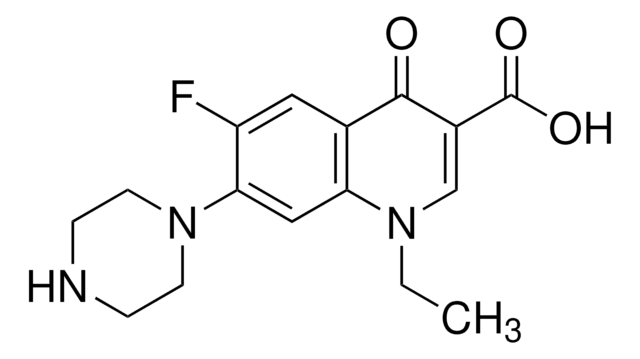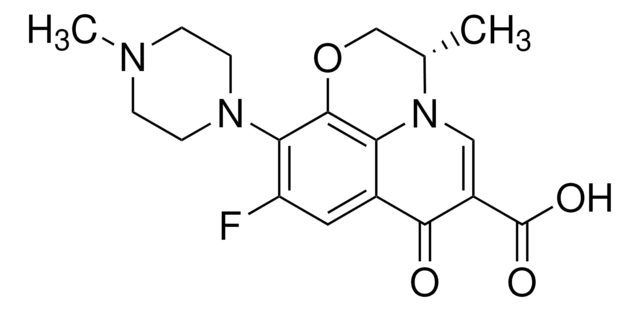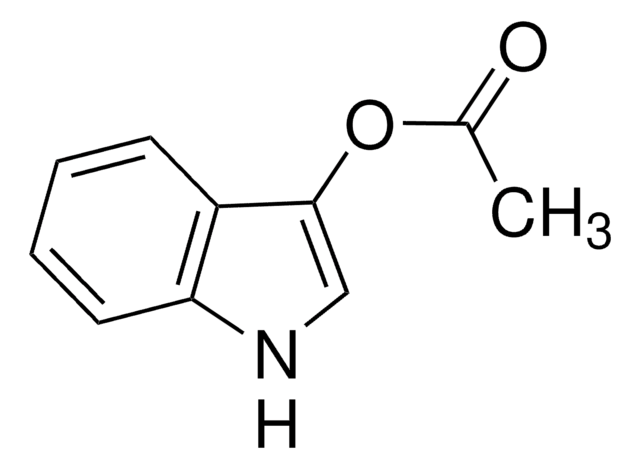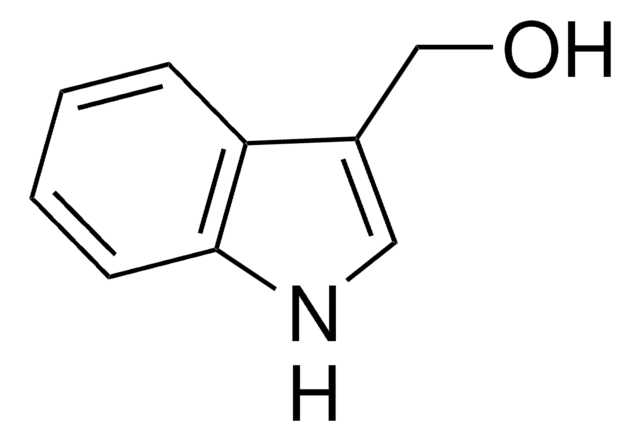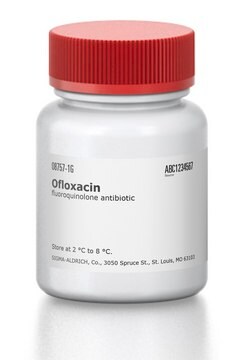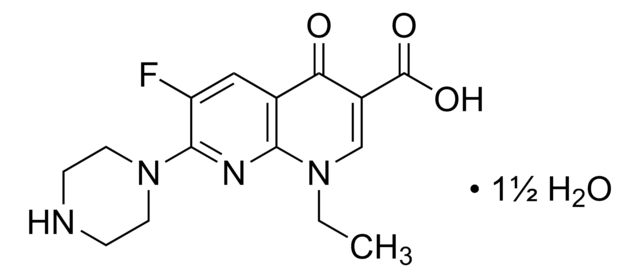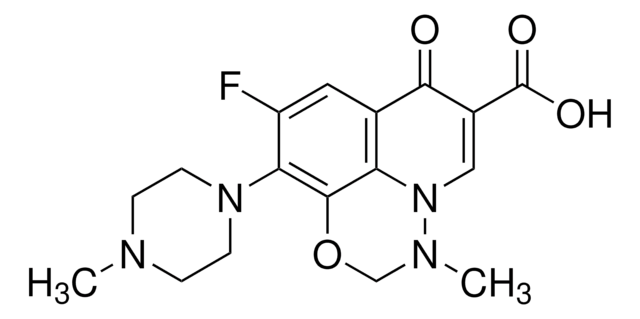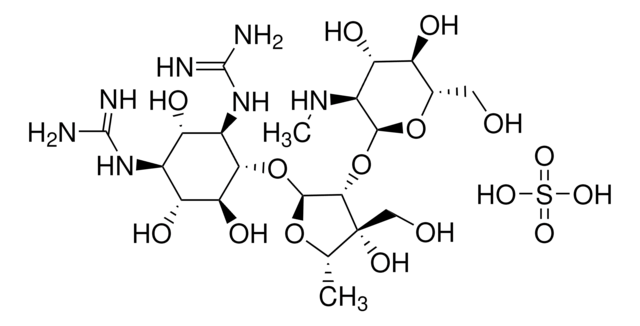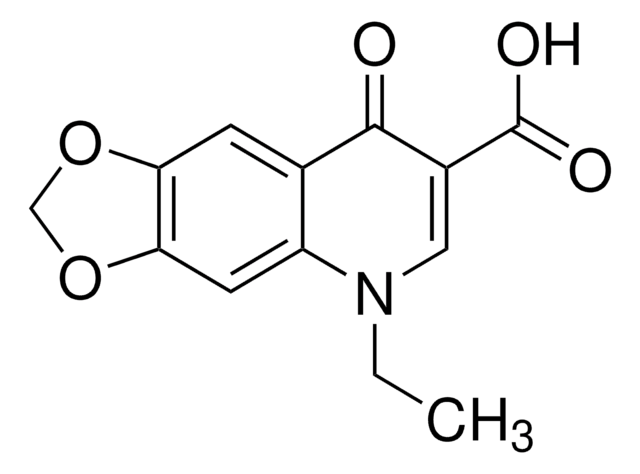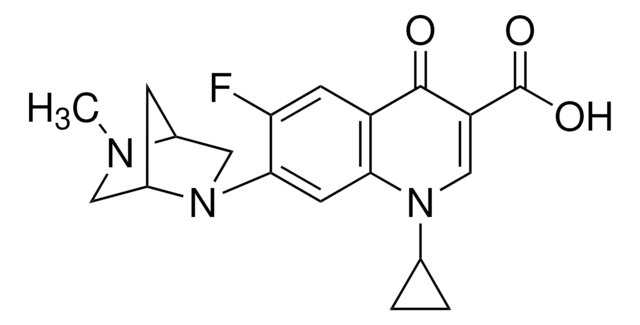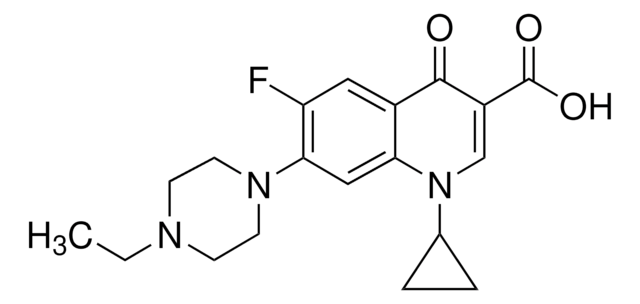推荐产品
生物源
synthetic
顏色
white to off-white
抗生素活性譜
Gram-negative bacteria
Gram-positive bacteria
作用方式
DNA synthesis | interferes
enzyme | inhibits
儲存溫度
−20°C
SMILES 字串
Cl.CCN1C=C(C(O)=O)C(=O)c2cc(F)c(N3CCNC(C)C3)c(F)c12
InChI
1S/C17H19F2N3O3.ClH/c1-3-21-8-11(17(24)25)16(23)10-6-12(18)15(13(19)14(10)21)22-5-4-20-9(2)7-22;/h6,8-9,20H,3-5,7H2,1-2H3,(H,24,25);1H
InChI 密鑰
KXEBLAPZMOQCKO-UHFFFAOYSA-N
相关类别
一般說明
Chemical structure: fluoroquinolone
應用
Lomefloxacin is a fluoroquinolone antibiotic that is commonly used to treat bacterial infections, including bronchitis and urinary tract infections. It is used as a pre-operative prophylactic to prevent urinary tract infection caused by S. pneumoniae, H. influenzae, S. aureus, P. aeruginosa, E. cloacae, P. mirabilis, C. civersus, S. asprphyticus, E. coli, and K. pneumoniae. It is used to induce genomic instability in mice and modification of the kinetics of growth of Gram-negative bacteria.
生化/生理作用
Lomefloxacin is a bactericidal fluoroquinolone agent that is active against gram-negative and gram-positive organisms. Lomefloxacin inhibits bacterial DNA gyrase (topoisomerase II) and topoisomerase IV, which are needed for the transcription and replication of bacterial DNA. DNA gyrase is thought to be the primary quinolone target for gram-negative bacteria. Topoisomerase IV is thought to be the primary target in gram-positive organisms. The inhibition of the topoisomerases results in strand breakage of the bacterial chromosome, supercoiling, and resealing. Therefore, DNA replication and transcription is inhibited.
其他客户在看
Yiruhan et al.
Environmental pollution (Barking, Essex : 1987), 158(7), 2350-2358 (2010-05-04)
Four fluoroquinolone antibiotics (norfloxacin, ciprofloxacin, lomefloxacin, and enrofloxacin) in tap water in Guangzhou and Macao were analyzed using high performance liquid chromatography fluorescence detection. The results showed that all target antibiotics were detected in high rate both in Guangzhou (77.5%)
Yongnian Ni et al.
The Analyst, 134(9), 1840-1847 (2009-08-18)
Three commonly used fluoroquinolone antibiotics (norfloxacin (NFX), ofloxacin (OFX) and lomefloxacin (LMFX)) were used as examples of molecules which can interact with a biomacromolecule, such as DNA, separately or in a mixture. Such interactions were investigated with the use of
Yoko Yoshihisa et al.
Experimental dermatology, 19(11), 1000-1006 (2010-09-04)
Intracellular reactive oxygen species (ROS) and apoptosis play important roles in the ultraviolet (UV)-induced inflammatory responses in the skin. Metal nanoparticles have been developed to increase the catalytic activity of metals, which is because of the large surface area of
Maria Rambla-Alegre et al.
Journal of chromatography. B, Analytical technologies in the biomedical and life sciences, 877(31), 3975-3981 (2009-10-27)
A sensitive and robust method was developed and validated for the routine identification and quantification of five quinolones in urine samples directly injected into a micellar liquid chromatographic system without any pre-treatment step. Since the simultaneous elution of the five
H Pruul et al.
The Journal of antimicrobial chemotherapy, 25(1), 91-101 (1990-01-01)
The post-antibiotic effect (PAE) of lomefloxacin against Escherichia coli and Pseudomonas aeruginosa was determined and compared with various other antibiotics. All the quinolones tested, and chloramphenicol and gentamicin, possessed PAE activity. At 10 x MIC and 30 min exposure, the
我们的科学家团队拥有各种研究领域经验,包括生命科学、材料科学、化学合成、色谱、分析及许多其他领域.
联系技术服务部门